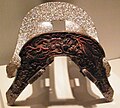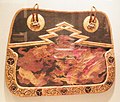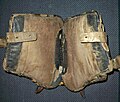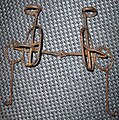Kura (saddle)

Kura (鞍) is the generic name for the Japanese
History and description
The Japanese were known to be using the Chinese style of saddle during the Nara period (AD 710 to 794), but during the Heian (794 to 1185), changes made to the Chinese saddle led to what we now call the kura or Japanese saddle. The Chinese style saddle is known as karagura while the Japanese style is known as yamatogura.[1]
In the fourth century AD, the Japanese started using horses in warfare.[2] Cavalry proved to be decisive in the Jinshin War of 672–73, in Fujiwara no Hirotsugu's rebellion in 740 and in the revolt of Fujiwara no Nakamaro in 756.[3]
Samurai warriors increasingly used horses,
Riding in a saddle was reserved for the samurai class until the end of the samurai era in 1868. Lower classes would ride on a
Types of kura
Yamato gura (Japanese style kura)
Kara gura (Chinese style kura)
Ni-gura or konida-gura (Kura for pack horses (ni-uma or konida-uma))
Kurabane
Kurabane is the wooden tree of the Japanese saddle which was made from red oak (kashi), the parts are connected to each other by joints and cords allowing the kurabane to flex, it has four parts, the maewa (pommel) the arched front plate, the shizuwa (cantle) the arched rear plate, these are connected by two igi (contoured side bands) which connect the maewa to the shizuwa, the igi rest on either side of the horse's spine and serve as the under frame for the leather seat (basen or kura tsubo), the igi are slotted for the stirrup straps (chikara-gawa or gekiso) to pass through.[11]
-
Maewa (pommel), the front arch of a Japanese saddle
-
Shizuwa (cantle), the back arch of a Japanese saddle
-
Igi (contoured side bands) of a Japanese saddle, showing the slot for the stirrup strap (Chikara-gawa or gekiso)
Basin or kura tsubo
The basin/kura tsubo (the thin leather saddle seat), has slots on either side for the stirrup straps (Chikara-gawa or gekiso) to pass through.
Aori
Aori (saddle flaps), a pair of large leather pieces that would hang from either side of the saddle (kura) and protect the sides of the horse from the
Shita-kura or hadazuke
Shita-kura or hadazuke, the twin set of double leather pads attached to the bottom of a Japanese saddle tree (kurabane). The shita-kura (hadazuke) protects the back of the horse from the kurabane.
Abumi
Chikara-gawa or gekiso
Chikara-gawa or gekiso (stirrup straps), leather straps that the stirrups (abumi) are attached to, they pass through slots on the saddle seat (basin or kura tsubo).[6]
Shiode
Shiode, tie-downs attached to the kura (saddle) at four points. Various ropes and straps are attached to the shiode.
Uma agemaki
Uma agemaki, decorative tassels that are attached to a Japanese saddle (kura), other equipment may be attached to the uma agemaki.
Bakin
Bakin, a padded cover that sits behind the kura (saddle) and covers the shirigai (crupper).
Shirigai
Shirigai, a type of crupper which connected to the kura (saddle) on one end and looped under the horse's tail on the other to keep the saddle from slipping forward.
Kutsuwa (bit)
Kiritsuke (saddle blanket)
Sanjakugawa
Sanjakugawa, two leather straps that wrapped around each side of the neck, attached to the bridle and the bit. The sanjakugawa prevented the bridle from slipping over the ears.
Muchi (whip)
-
Antique Japanese horse whip
Munagai (breast strap)
Omogai (bridle)
Tazuna (reins)
Obukuro (tail cover)
See also
- Yabusame (Japanese archery on horseback)
References
- ISBN 9780195331264, P.156
- ^ Nussbaum, Louis Frédéric and Käthe Roth. (2005). "Horses" in Japan Encyclopedia, pp. 354–355;, p. 354, at Google Books citing the Kojiki and Nihon shoki.
- ^ Friday, Karl F. (1996). Hired Swords: The Rise of Private Warrior Power in Early Japan, p. 37, p. 37, at Google Books
- ^ Turnbull, Stephen R. (2002). War in Japan 1467–1615, pp. 15–20., p. 15, at Google Books
- ^ Samurai, warfare and the state in early medieval Japan (Google eBook), Karl Friday, Psychology Press, 2004 P.97
- ^ a b Handbook to life in medieval and early modern Japan, William E. Deal, Oxford University Press US, 2007 P.155
- ^ Honda the samurai: a story of modern Japan, Author William Elliot Griffis, Publisher Congregational Sunday-school and publishing society, 1890, Original from Harvard University P.146
- ISBN 978-0-521-52918-1, P.88
- ISBN 978-1-84176-951-6, P.121
- ^ Reports of Military Observers Attached to the Armies in Manchuria During the Russo-Japanese War ...: Reports of W. S. Schuyler, J. F. Morrison, Carl Reichmann P. C. March, Govt. Print. Off., 1907 P.107
- ISBN 978-0-300-17636-0, P.81









































